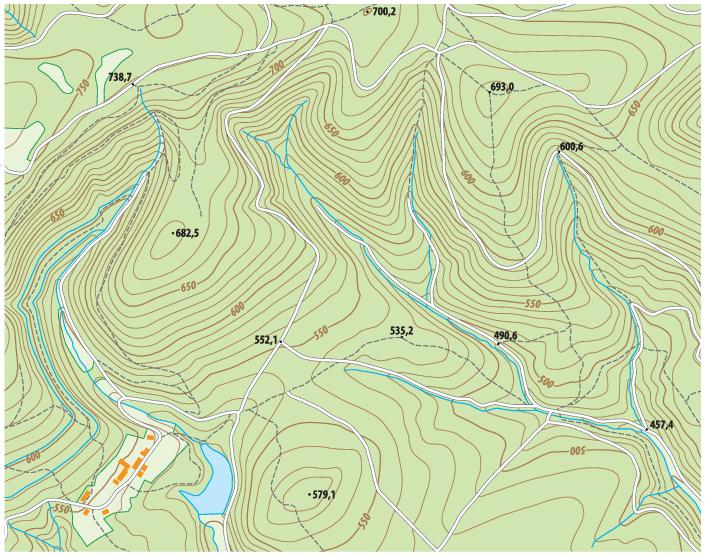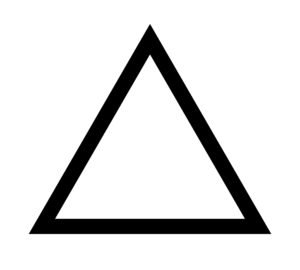There are many types of maps available for the public to use. Some maps are free to use and others are commercially available with road maps being perhaps one of the most popular and well-known types. However, there are specialty maps, such as topographic maps, that are designed for uses other than just finding where things and places are located.
A topographic map is a tool that displays the physical shape and features on the surface of the earth (the topography) usually in two-dimensional form using a plan view (looking down from above). This type of map would show the shape of the land (both natural and man-made) as well as other natural features such as woodlands, wetlands, creeks, and other bodies of water. Some examples of existing man-made features that would be shown in a topographic map would include buildings, roads, and parking lots.
Because of the two-dimensional form, the differences in elevations are represented by contour lines (sometimes referred to as just contours).
Contour lines are simply the lines on the map that represent the same elevation above sea level. If you were to walk along a contour line as shown on a map, you would be walking along a flat path since there would be no change in elevation along the path.
The contour line interval is the elevation difference between adjacent contour lines. This interval can vary between maps but can range anywhere from one foot to as much as 20 feet between contour lines.
What can also vary is how often the contour lines are labeled. Some maps could have every contour labeled and others could have a label every ten feet of elevation difference. In this example, the labeled contour lines (every ten feet) are called index contours. The contour lines between the index counters are called intermediate contour lines. The index contours are usually shown in a way so that someone can easily tell them apart from the intermediate contour lines. Index contours may be bolder than the intermediate contours or they may be lines with longer dashes with the intermediate contour lines having shorter dashes.
Advertisement
Who Uses These Kinds of Maps?
Topographic maps can be used by many different kinds of people.
Local municipalities might have a need for these types of maps to help with land planning. A state department of transportation might need to have a detailed topographic map to design a new highway project or to tie a new road into an existing system.
An individual homeowner might want to simply have a topographic map for a property to help plan for a future building addition or landscaping project. A map like this might have to involve a professional land surveyor to prepare a detailed survey plan.
There are various kinds of topographic maps designed for different users based on how the information within the map will be used.
Topographic Survey Plans Are Important for Land Development
Having a topographic map is especially important for a proposed land development project. In particular, having a topographic survey plan developed by a surveying company is usually necessary to know how to tie the proposed construction into the existing ground, existing roads, existing drainage systems, and other existing features of the land. This survey would also be used determine what existing features (such as vegetation) would have to be removed and what would stay after construction.
A survey plan like this is often referred to as an “Existing Conditions Plan” or a survey base plan.
Related: 11 Common Parts of a Topographic Map
Related: What Is Land Development and What Is Involved?
Topographic Maps Provide Valuable Information
Unlike the more common road map (used for finding locations) or even an aerial map (used for seeing what an area of land actually looks like from above), a topographic map can provide much more information than just the locations of places, roads, woods areas, and bodies of water. This type of map can be used to see the elevations of these land features in relation to each other. These maps can be used to locate high points, low points, which direction stormwater runoff flows, and which bodies of water into which a property runs. They can also be used to determine ground slopes.
A topographic survey plan of a specific property could even show as much detail as all buildings, roads, driveways, and utility poles within the surveyed area of interest.
Advertisement
Where to Get Topographic Maps
If you want a detailed survey for a property, you would have to hire a professional surveyor to create a topographic survey plan for your site.
Otherwise, topographic maps that already exist can be obtained for free online and are also commercially available.
The free maps would involve doing some internet research. You would search to see if either your local municipality or your state offers public access to their GIS (Geographical Information System) database which should likely include access to topographic information. For your search term, you could simply combine the name of your municipality or state with the term “GIS” to begin your search.
The USGS (United States Geological Survey) also provides free access to GIS data and topographic maps.
Here is a good starting point for locating USGS topographic maps.
Many of the free maps mentioned above could also include tools within the website that allow you to measures things like distances and areas.
A Topographic Map Is a Valuable Resource
Just like with the other kinds of maps that are available for use, a topographic map is another tool that can be a valuable resource depending on what you use it for. How you intend to use the map would determine which topographic map you choose to obtain.
Related: How to Read a Topographic Map
Related: Recommendations for Topographic Maps



